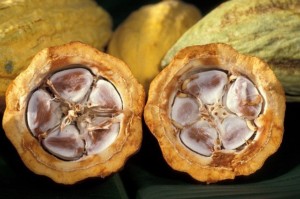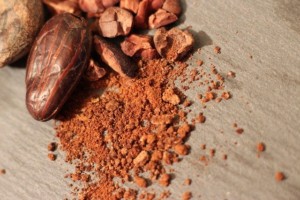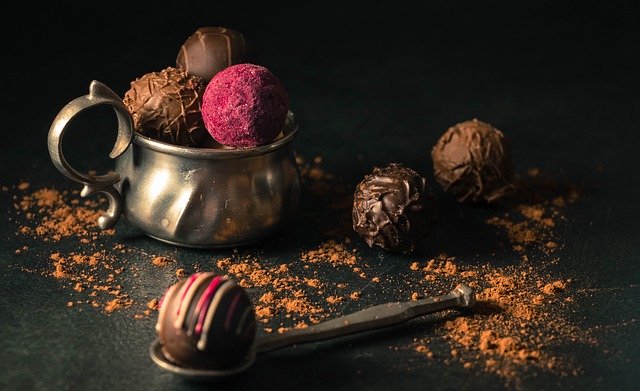At first glance, cacao and cocoa almost seem like the same word, but technically they describe two different products.
 All chocolate comes from the cacao plant, an evergreen tree that grows to 15 to 25’ feet tall and which is found in countries near the equator (such as South America, Africa, and Asia). Fruit, called a “pod,” grows directly from the trunk of the cacao tree. Each pod contains 20-60 cocoa beans, and it takes 7 to 14 pods to produce one pound of dry cocoa beans.
All chocolate comes from the cacao plant, an evergreen tree that grows to 15 to 25’ feet tall and which is found in countries near the equator (such as South America, Africa, and Asia). Fruit, called a “pod,” grows directly from the trunk of the cacao tree. Each pod contains 20-60 cocoa beans, and it takes 7 to 14 pods to produce one pound of dry cocoa beans.
 Cacao is the term for the pods, beans, and ground-up contents of the beans such as cacao nibs. Cocoa is the term typically used for the powder left after pressing the fat out of the ground beans. Cocoa and cacao contain similar amounts of nutrients, and the terminology is often fuzzy.
Cacao is the term for the pods, beans, and ground-up contents of the beans such as cacao nibs. Cocoa is the term typically used for the powder left after pressing the fat out of the ground beans. Cocoa and cacao contain similar amounts of nutrients, and the terminology is often fuzzy.
Cacao beans go through several steps before they develop their characteristic chocolate flavor:
- Cacao beans are put into covered bins for a few days so that microbes can begin the fermentation process to develop a chocolate flavor.
- The fermented cacao beans are then dried and sorted.
- The dried beans are roasted to more fully develop the chocolate taste.
- The roasted beans are then crushed and separated from their outer hulls, producing cacao nibs.
- The cacao nibs are ground to produce a liquid substance called the liquor (it doesn’t contain any alcohol).
- Chocolate liquor is then processed to remove the fat, called cocoa butter, to produce cocoa powder.
- To make chocolate bars and candy, the liquor is mixed with other ingredients such as sugar, vanilla, milk, or more cocoa butter.
Nutrition Facts:
Cocoa butter contains both monounsaturated and saturated fats. Although most types of saturated fat play a role in developing heart disease, one of the saturated fats found in cocoa butter, stearic acid, does not have negative effects on cholesterol levels. Some research actually shows that eating dark chocolate may help protect against heart disease.
Cocoa and cacao are good sources of fiber, although the amount of fiber in various chocolate products varies quite a bit. Dry cacao or cocoa powder contains the most fiber, while milk chocolate contains only a very small amount of fiber.
Cacao contains large concentrations of a variety of different types of antioxidants. Processing from cacao to cocoa destroys many of the antioxidants, which means that cacao is higher in antioxidants including flavanols, proanthocyanidins, and anthocyanins than cocoa. Further processing into chocolate candy bars destroys even more of the antioxidants. The average flavanol content of dark chocolate is approximately 5 times as much as the flavanols in milk chocolate because milk chocolate contains far less cacao and more fat and sugar.
Cocoa and cacao also contain minerals and compounds that act as nervous system stimulants, diuretics, and smooth muscle relaxants.
Cacao nibs, the crunchy bits of fermented, dried, roasted, and crushed cacao beans, are becoming part of our everyday food choices and are often used instead of chocolate chips in baking. Cacao nibs contain no sugar and instead of a smooth, sweet chocolate flavor, they have a more complex, bitter flavor.
- One tablespoon of unsweetened cocoa powder: 12 calories, 1 g protein, 1 g fat, .4g saturated fat, .3g monounsaturated fat, 3 g carbohydrate, .09 g sugars, 2 g fiber
- One tablespoon of cacao powder: 29 calories, 1 g protein, 1 g fat, 0g saturated fat, 4 g carbohydrate, no sugars, 1g fiber
- One ounce of cacao nibs: 130 calories, 4g protein, 12g fat, 7g saturated fat, 10g carbohydrate, no sugars, 9g fiber
- One ounce of semi-sweet chocolate chips: 140 calories, 2g protein, 8g fat, 5g saturated fat, 20g carbohydrate, 16g sugars, 2g fiber
Chocolate and Health:
Research has shown a protective association – not a cause and effect – of dark chocolate on health, including reduced risk of cardiovascular disease and diabetes as well as improved mood.
 A 2009 Swedish study looked at cardiac mortality in nondiabetic people hospitalized with their first heart attack. After a mean 8.6 years of follow-up, people who reported eating chocolate twice or more per week were 66% less likely to die from heart disease compared to people who never ate chocolate. The antioxidants in cacao and cocoa appear to decrease inflammation and help protect arteries to promote smooth blood flow which can help lower blood pressure. Some research indicates that the antioxidants in cacao and cocoa may help decrease inflammation and insulin resistance associated with elevated blood sugar levels in diabetes.
A 2009 Swedish study looked at cardiac mortality in nondiabetic people hospitalized with their first heart attack. After a mean 8.6 years of follow-up, people who reported eating chocolate twice or more per week were 66% less likely to die from heart disease compared to people who never ate chocolate. The antioxidants in cacao and cocoa appear to decrease inflammation and help protect arteries to promote smooth blood flow which can help lower blood pressure. Some research indicates that the antioxidants in cacao and cocoa may help decrease inflammation and insulin resistance associated with elevated blood sugar levels in diabetes.
There are also some health conditions where cacao and cocoa may have a negative effect, including acne, heartburn, and migraines in some people. Cacao, cocoa and chocolate contain caffeine, with cacao and cacao nibs containing the highest levels of caffeine.
Most research studies use about 1 ounce of dark chocolate with at least 70% cacao solids per day. The higher the percentage of cacao solids, the more beneficial antioxidants and nutrients remain in the chocolate.
The type of chocolate consumed most often in the United States is milk chocolate, which typically contains 10%–12% cocoa liquor and lower amounts of antioxidants. Semisweet or bittersweet chocolate is often referred to as dark chocolate and must contain no less than 35% by weight of cocoa liquor. White chocolate contains only cocoa butter (at least 20% by weight) combined with sweeteners and dairy ingredients and is very low in antioxidants.
Our Chocolate Tips:
We like to believe that any type of chocolate product contains beneficial nutrients, because who doesn’t like eating chocolate? The reality is that many types of chocolate contain large amounts of added sugars that drive up the calories and decrease the antioxidant benefits of cocoa. Unsweetened cocoa or cacao powder isn’t the melt-in-your-mouth treat that we expect from chocolate, but it’s a source of fiber and contains several trace amounts of minerals including iron, calcium, phosphorus, zinc and niacin.
To enjoy the nutrient benefits of cocoa, cacao powder, or cacao nibs without added sugar:
- Mix 1 tablespoon of cocoa or cacao nibs in your morning oatmeal with fresh or frozen fruit and nuts.
- Blend 1 tablespoon of cocoa or cacao nibs into a fruit and yogurt smoothie.
- Flavor plain yogurt with cocoa powder and a drizzle of maple syrup or honey.
- Add cocoa powder to your morning coffee for a mocha flavor without added sugar.
- Make your own sugar-free nut/chocolate spread by mixing cocoa powder into your favorite peanut or almond butter.
- Toss cacao nibs in trail mix with nuts and seeds instead of chocolate chips.
- Add cocoa powder or cacao nibs to sauces like a mole sauce for a deeper flavor.
- Choose dark chocolate with at least 70% cacao solids and enjoy no more than 1 ounce per day.
By Lynn Grieger, RDN, CDE, CPT, CHWC
Copyright foodandhealth.com, reprinted with permission.

